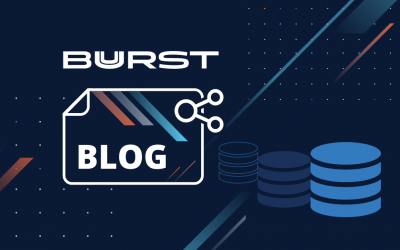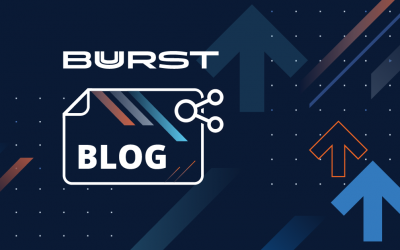“Get your On-Premises NAS in the Azure Cloud”. Download the full slide deck on Slideshare.
Looking to transition your enterprise applications to the highly-available Azure cloud? No time/budget to re-write your applications to move them to Azure? SoftNAS Cloud NAS extends Azure Blob storage with enterprise-class NAS file services, making it easy to move to Azure. In this post, we will discover how you can quickly and easily:
– Configure Windows servers on Azure with full Active Directory control
– Enable enterprise-class NAS storage in the Azure cloud
– Provide disaster recovery and data replication to the Azure cloud
– Provide highly available shared storage
Get your On-Premises NAS in the Azure Cloud
My name is Matt Blanchard. I am a principal solutions architect, we’re going to talk about some of the advantages of using Microsoft Azure for your cloud storage devices inside the cloud and helping you make plans to move from your on-premise solution today into the cloud of tomorrow.
This is not a new concept. This is what we’ve seen in trend for the last several years. The bill versus buy aspect is where we’re going to have a great economy of scale whenever we buy assets or we buy an OpEx partner and we are able to use that type of partnership to advance our IT needs versus a low economy of scale. If I have to invest my own money to build up the information systems and buy large SAN suppliers in networking, storage networks, and so forth. Hosting that and building that all out myself makes a lot of capital investment. This is the paradigm.
On-premise vs the cloud architecture.

A lot of the things that we see that we have to provide for ourselves on-premise are things that are assumed and given to us in configurations in the cloud, such as with Microsoft Azure giving us the availability to have full-fledged VMs running inside of our Azure repository and accessing our SoftNAS virtual SAN. We are able to give you network access control towards all your storage needs within a packaged small useable space.
On-premise vs in the cloud
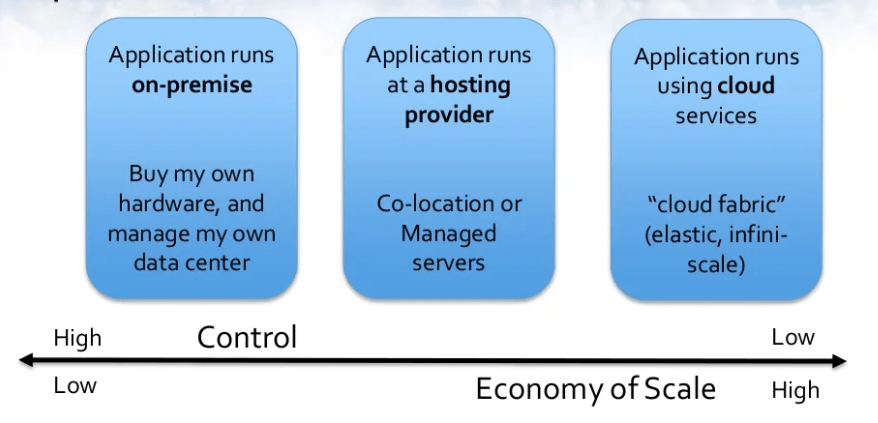
I don’t have to build my own data center. I can have all my applications running in the cloud on-services versus having them on-premise running physically and having to maintain them physically on datasets.
If you think about rebuilding applications for the next generation of databases or having the next generation of server componentry that we’re going to install that may not have the correct driver sets for our applications and having to rebuild all those things. It makes it quite tedious to help move forward with your architecture.
However, when we start to blow those lines and move into let’s say a hosting provider or cloud services, those dependencies on the actual hardware devices and the physical device drivers start to fade away because we’re running these applications as services and not as physically supported sideload architectures.
This movement towards Azure in the cloud makes quite a bit of sense whenever you start looking at the economies of scale, how fast we could grow in capacity, and things like bursting control whenever we have large amounts of data services that we’re going to have to supply on-demand versus things that we have on a constant day-to-day basis.
Say we are a big software company or a big game company that’s releasing the next new Star Wars game. I’ll have to TM that or something in my conversation. You’ll have to see us. It might be some sort of online game that needs extra capacity for the first weekend out just to support all the new users who’re going to be accessing that.
This burst ability and this expandability into the cloud make all the sense in the world because who wants to spend that money on that hardware to build out that infrastructure for something that may or may not continue to be that large of an investment in the future? If we can scale that down over time or scale it up over time, either way. Maybe we undersized our built. You can think of it in that aspect.
It really makes sense – this paradigm switched into the cloud mantra.
Flexible, Adaptable Architecture
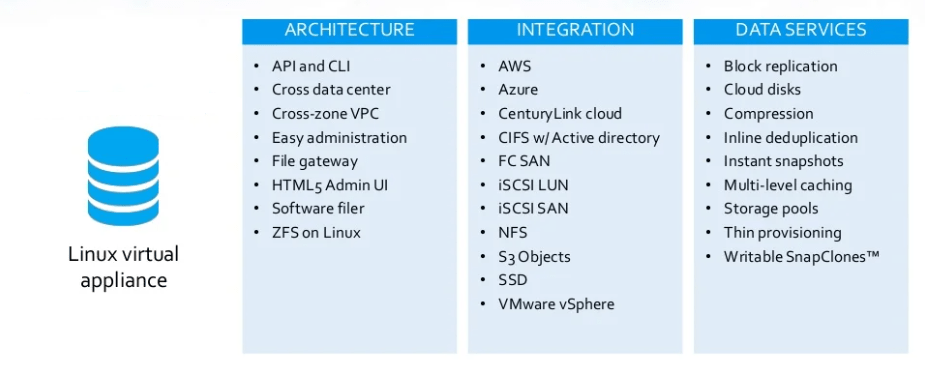
At Buurst, we’ve built our architecture to be flexible and adaptable inside of this cloud architecture. We’ve built a Linux virtual machine; it’s built on CentOS. It runs ZFS as our file system on that kernel. We run all of our systems on open controllable systems. We have staff on-site that contribute to these open-source amalgams to make these systems better into CentOS and ZFS. We contribute a lot of intellectual property to help advance these technologies into the future.
We, of course, run HTML5 as our admin UI, we have PHP, and Apace is our web server. We have all these open systems to allow us to be able to take advantage of a great open-source community out there on the internet.
We integrate with multiple different service users. If you have customers that are currently running in AWS or CenturyLink Cloud and they are looking to migrate into Azure — make a change — it’s very easy for us to come in and help you make that data migration change because inserting SoftNAS service into both of those service providers and then simply migrating that data is very simple and easy to do the task.
We really do take in responses. We want to be flexible. We want to be open. We want to have all of our data resources that have multiple use cases. We are able a full-featured NAS service that does all of these things in the data services tab.
Block replication, we can do inline deduplication, caching, storage pools, thin provisioning, writable snapshots, and snap clones. We can do compression and encryption. With all of these different offerings, we are able to give you a single packaged NAS solution.
Once again, all the things that you think you’ll come back in like, “I’m going to have to implement all of that stuff. I’m going to have to buy all these different componentry and insert them into my hardware,” those are things that are assumed and used and we are able to go ahead and give you directly in our NAS solution.
How does SoftNAS work?
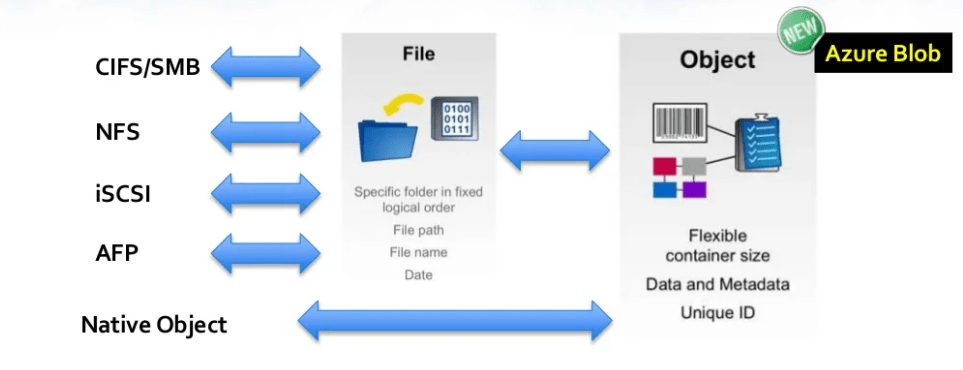
To be very forthcoming, it’s basically a gateway technology. We are able to present storage capacity whether it be a CIFS or SMB access medium for Windows users for some sort of Windows file share or if it’s an NFS share for some Linux machines or even just an iSCSI block device or an Apple File Protocol for entire machine backups.
If you have end-users or end devices that need storage repositories of multiple different protocols, we are able then to store that data into say an Azure Blob Storage or even a native Azure storage device. We are able then to translate those protocols into an object protocol, which is not a native language. We don’t speak in object whenever we’re going through a normal SMB connection, but we do also speak native object directly into Azure Blob. We offer the best of both worlds with this solution.
Just the same as native block devices, we have a native block protocol that we are to talk directly into Azure disks that directly attach to these machines. We are able to create flexible containers that make data unifiable and accessible.
SoftNAS Cloud NAS on Azure
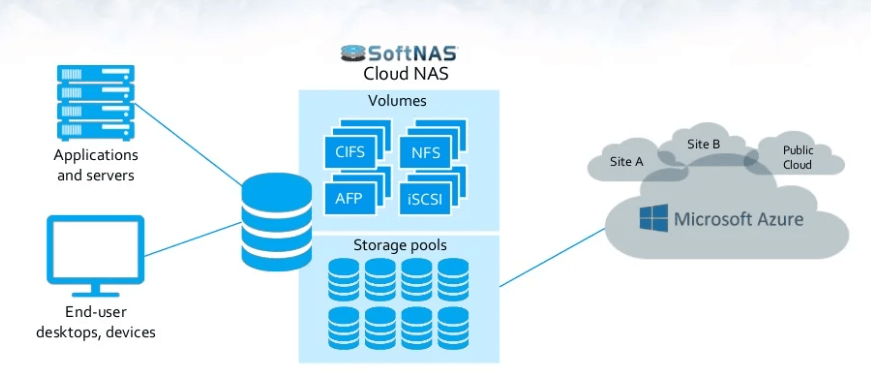
What we’re basically going to do is we’re going to present a single IP point of access that all of these file systems will land on. All of our CIFS access, all of our NFS exports, and all of the AFP shares will all be enumerated out on a single SoftNAS instance and they will be presented to these applications, servers, and end-users.
The storage pools are nothing more than conglomerations of disks that have been offered up by the Microsoft Azure platform. Whether it’s Microsoft Blob or it’s just native disks, if it’s even another type of object device that you’ve imported into these drives, we can support all of those device types and create storage pools of different technologies.
And we can attach volumes and LUNs that have shares of different protocols to those storage pools so it allows us to have multiple different connection points to different storage technologies on the backend. And we do this as a basic translation and it’s all seamless to the end-user or the end device.
NFS/CIFS/iSCSI Storage on Azure Cloud
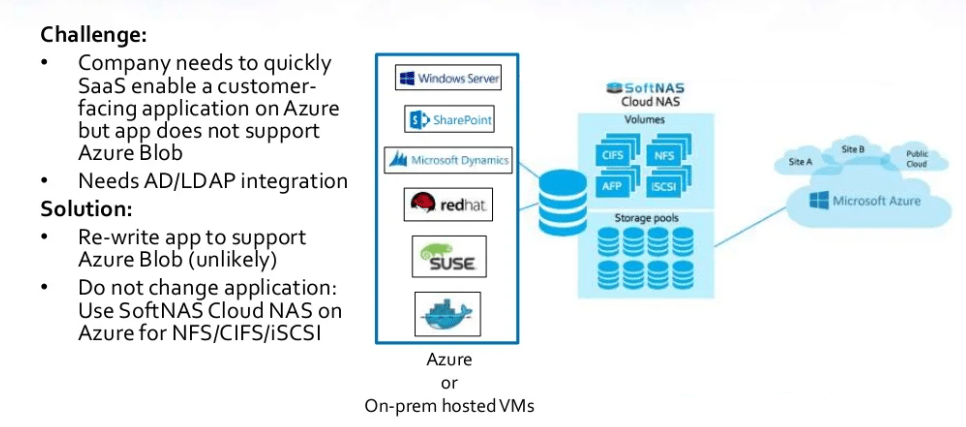
A couple of use cases where SoftNAS and Azure really make sense. I’m going to go through these and talk about the challenge. The challenge would be a company needs to quickly SaaS-enable a customer-facing application on Azure but the app doesn’t support blob. They also need LDI or LDAP Integration for that application. What would the solution be? Basically, the solution will be rewriting your application to support blob and AD authentications. That is highly unlikely that it would ever happen.
Instead of rewriting that application to support blob, continue to do business the way you always have. That machine needs access via NFS, fine. We’ll just support that via NFS through SoftNAS.
Drop all that data on a Microsoft Azure backend, store it in the blob, and let us do the translation. Very simple access so then we could have access for all of our applications on-premise or in the cloud directly to whatever data resources they need and it could be presented with any protocol that’s listed – via CIFS, NFS, AFP, iSCSI.
Disaster Recovery on Azure Cloud
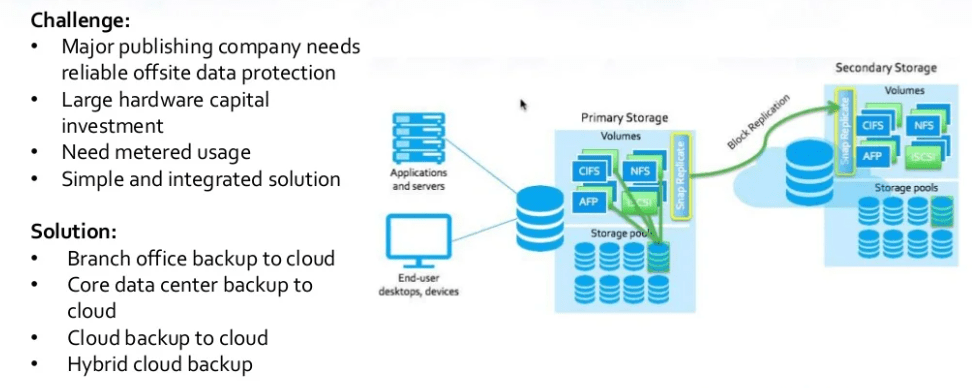
Maybe you have a big EMC array at their location that you have several years of support left on. You need to be able to meter the use of it, but you need to be able to have a simple integration solution. What would be the solution?
It would be very easy to spin up a SoftNAS instance on the premise, directly access that EMC array, and utilize the data resources for SoftNAS. We can then represent those data repositories to their application servers and end-users on site and replicate all that data using Snapreplicate into Microsoft Azure.
We would have our secondary blob storage in Azure and we’d be replicating all that data that’s on-premise into the cloud.
What’s great about this solution is it becomes a gateway drive when I get to the end of support on that EMC array and says, “We need to go buy a new array or we need to have support for that array.” We’ve got this thing running in Azure already, why don’t we just cut the code? It is the exact same thing that’s running in Azure. We could just start directing our application resources to Azure. It’s a great way to get you moving into the cloud and get a migration strategy moving forward.
Hybrid on-premise storage getway to Azure Cloud
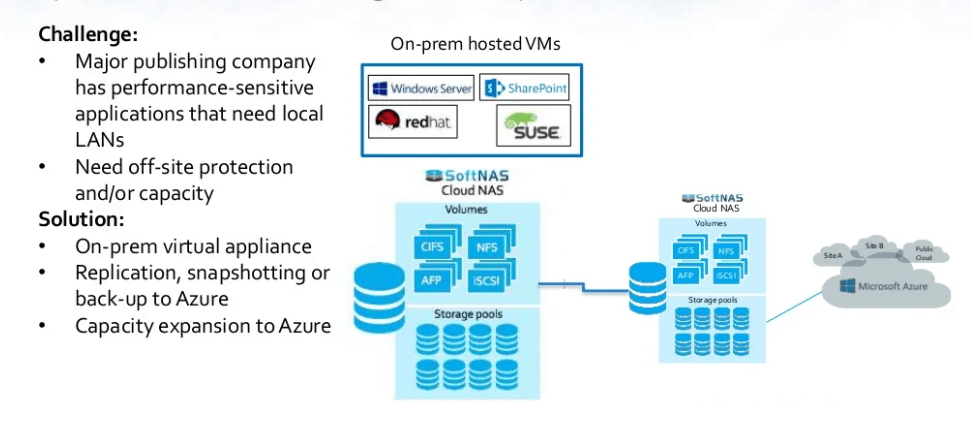
The last one is hybrid on-premise usage and I alluded to this one earlier about the burst to cloud type of thing. This is a company that has performance-sensitive applications that need a local LAN. They need off-site protection or capacity. The solution basically would be to set up replication to Azure and then have that expand capacity. So basically whenever they run out of space on-premise, we would then be able to burst out into Azure and create more and more virtual machines to access that data.
Maybe it’s a web services account that has a web portal UI or something like that that needs just a web presence. Then we’re able to multiple copies of different web servers that are load balanced all accessing the same data on top of Microsoft Azure through SoftNAS AZUR NAS Storage Solution.


